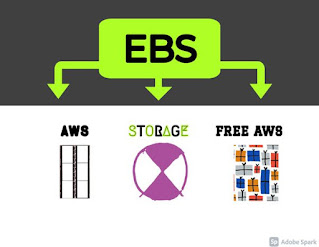Amazon Elastic Block Store (Amazon EBS) provides persistent block storage volumes to use with Amazon EC2 instances in the AWS Cloud. Each Amazon EBS volume is automatically replicated within its Availability Zone to protect you from component failure, offering high availability and durability.
Amazon EBS volumes offer the consistent and low-latency performance needed to run your workloads. With Amazon EBS, you can scale your usage up or down within minutes—all while paying a low price for only what you provision.

Amazon EBS Features.
- Choose between solid-state disk (SSD)-backed or hard disk drive (HDD)-backed volumes that can deliver the performance you need for your most demanding applications.
- Availability: Each Amazon EBS volume is designed for 99.999% availability and automatically replicates within its Availability Zone to protect your applications from component failure.
- Encryption: Amazon EBS encryption provides seamless support for data-at-rest and data-in-transit between EC2 instances and EBS volumes.
- Access Management: Amazon’s flexible access control policies allow you to specify who can access which EBS volumes ensuring secure access to your data.
- Snapshots: Protect your data by creating point-in-time snapshots of EBS volumes, which are backed up to Amazon S3 for long-term durability.
What is Elastic Block Store?
- Amazon Elastic Block Store (EBS) provides raw block-level storage that can be attached to Amazon EC2 instances.
- These block devices can then be used like any raw block device. In a typical use case, this would include formatting the device with a filesystem and mounting said filesystem.
- In addition, EBS supports a number of advanced storage features, including snapshotting and cloning. As of June 2014, EBS volumes can be up to 1TB in size. EBS volumes are built on replicated back-end storage so that the failure of a single component will not cause data loss.
AWF Free Online Resources.
The EBS product was introduced to the general public by Amazon in August 2008 and as of April 2017, 30 GB of free space is included in the free trial of Amazon Web Services.



.jpg)
Comments
Post a Comment
Thanks for your message. We will get back you.